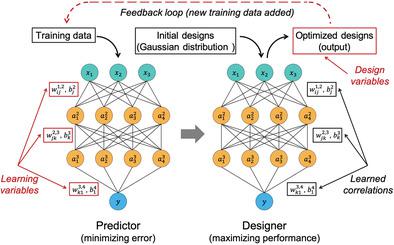Our official English website, www.x-mol.net, welcomes your
feedback! (Note: you will need to create a separate account there.)
Generative Deep Neural Networks for Inverse Materials Design Using Backpropagation and Active Learning.
Advanced Science ( IF 14.3 ) Pub Date : 2020-01-09 , DOI: 10.1002/advs.201902607 Chun-Teh Chen 1 , Grace X Gu 2
Advanced Science ( IF 14.3 ) Pub Date : 2020-01-09 , DOI: 10.1002/advs.201902607 Chun-Teh Chen 1 , Grace X Gu 2
Affiliation

|
In recent years, machine learning (ML) techniques are seen to be promising tools to discover and design novel materials. However, the lack of robust inverse design approaches to identify promising candidate materials without exploring the entire design space causes a fundamental bottleneck. A general-purpose inverse design approach is presented using generative inverse design networks. This ML-based inverse design approach uses backpropagation to calculate the analytical gradients of an objective function with respect to design variables. This inverse design approach is capable of overcoming local minima traps by using backpropagation to provide rapid calculations of gradient information and running millions of optimizations with different initial values. Furthermore, an active learning strategy is adopted in the inverse design approach to improve the performance of candidate materials and reduce the amount of training data needed to do so. Compared to passive learning, the active learning strategy is capable of generating better designs and reducing the amount of training data by at least an order-of-magnitude in the case study on composite materials. The inverse design approach is compared with conventional gradient-based topology optimization and gradient-free genetic algorithms and the pros and cons of each method are discussed when applied to materials discovery and design problems.
中文翻译:

使用反向传播和主动学习的逆材料设计的生成型深度神经网络。
近年来,机器学习(ML)技术被视为发现和设计新颖材料的有前途的工具。然而,缺乏可靠的逆向设计方法来确定有希望的候选材料而不探索整个设计空间会导致基本瓶颈。提出了一种利用生成逆设计网络的通用逆设计方法。这种基于ML的逆设计方法使用反向传播来计算目标函数相对于设计变量的解析梯度。这种反向设计方法能够通过使用反向传播来提供梯度信息的快速计算,并使用不同的初始值运行数百万次优化,从而克服了局部最小值陷阱。此外,逆向设计方法采用主动学习策略,以提高候选材料的性能并减少这样做所需的训练数据量。与被动学习相比,主动学习策略能够生成更好的设计,并在复合材料的案例研究中将训练数据的数量减少至少一个数量级。将逆设计方法与常规的基于梯度的拓扑优化和无梯度遗传算法进行了比较,并讨论了每种方法应用于材料发现和设计问题时的利弊。在复合材料的案例研究中,主动学习策略能够生成更好的设计,并至少减少数量级的训练数据。将逆设计方法与常规的基于梯度的拓扑优化和无梯度遗传算法进行了比较,并讨论了每种方法应用于材料发现和设计问题时的利弊。在复合材料的案例研究中,主动学习策略能够生成更好的设计,并至少减少数量级的训练数据。将逆设计方法与常规的基于梯度的拓扑优化和无梯度遗传算法进行了比较,并讨论了每种方法应用于材料发现和设计问题时的利弊。
更新日期:2020-01-09
中文翻译:

使用反向传播和主动学习的逆材料设计的生成型深度神经网络。
近年来,机器学习(ML)技术被视为发现和设计新颖材料的有前途的工具。然而,缺乏可靠的逆向设计方法来确定有希望的候选材料而不探索整个设计空间会导致基本瓶颈。提出了一种利用生成逆设计网络的通用逆设计方法。这种基于ML的逆设计方法使用反向传播来计算目标函数相对于设计变量的解析梯度。这种反向设计方法能够通过使用反向传播来提供梯度信息的快速计算,并使用不同的初始值运行数百万次优化,从而克服了局部最小值陷阱。此外,逆向设计方法采用主动学习策略,以提高候选材料的性能并减少这样做所需的训练数据量。与被动学习相比,主动学习策略能够生成更好的设计,并在复合材料的案例研究中将训练数据的数量减少至少一个数量级。将逆设计方法与常规的基于梯度的拓扑优化和无梯度遗传算法进行了比较,并讨论了每种方法应用于材料发现和设计问题时的利弊。在复合材料的案例研究中,主动学习策略能够生成更好的设计,并至少减少数量级的训练数据。将逆设计方法与常规的基于梯度的拓扑优化和无梯度遗传算法进行了比较,并讨论了每种方法应用于材料发现和设计问题时的利弊。在复合材料的案例研究中,主动学习策略能够生成更好的设计,并至少减少数量级的训练数据。将逆设计方法与常规的基于梯度的拓扑优化和无梯度遗传算法进行了比较,并讨论了每种方法应用于材料发现和设计问题时的利弊。










































 京公网安备 11010802027423号
京公网安备 11010802027423号